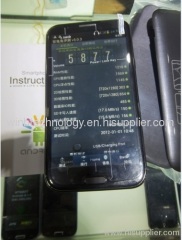
|
winbtechnology electroics co ltd
|
unlocked 5inch 1280X720 2G RAM smart phone digital push to talk push to talk Dpmr smart phone ip68 grade
| Price: | 599.0 USD |
| Payment Terms: | T/T,L/C,WU;paypal moneygram |
| Place of Origin: | Guangdong, China (Mainland) |
|
|
|
| Add to My Favorites | |
| HiSupplier Escrow |
Product Detail
DPMR push to talk 400-480mhz UHF walkie talkie DMR PPT for outdoor for military for mining lone worker use smart phone
DPMR push to talk 400-480mhz UHF walkie talkie DMR PPT for outdoor for military for mining lone worker use smart phone
DPMR push to talk 400-480mhz UHF walkie talkie for outdoor for military for mining lone worker use smart phone
DPMR push to talk 400-480mhz UHF walkie talkie DMR PPT for outdoor for military for mining lone worker use smart phone
DPMR push to talk 400-480mhz UHF NFC rugged phone 2G RAM New factory 5INCH Phone!! 5inch Original NFC Mobile Phone IP68 Waterproof DPMR Walkie talK push to talk
DPMR Digital Two Way Radio DP-100
Specifications
DPMR Digital Two Way Radio DP-100
1.Dual Modes of Analog & Digital
2.Superior Voice and Audio
3. DPMR
DPMR Digital Two Way Radio DP-100
Detailed Specification:
first android phone with DMR dPMR digital 2 way radio
Waterproof Dustproof IP67 Outdoor Rugged Mobile Phone With GPS, Walkie Talkie
2 way radios have low running costs and no call charges. This makes them one of the most cost-effective ways of communicating with staff and vehicle fleets on the move. From local on-site, short-range business radio systems to full regional coverage, our two way radio systems can provide both voice and data communications.
push to talk
Waterproof Dustproof IP67 Outdoor Rugged Mobile Phone With GPS, Walkie Talkie
http://dpmr-mou.org










Until now, TDMA was more spectrum efficient at wider channel spacing's like 25kHz, as for example, two or three users could access the same bandwidth as one FDMA channel user. However, in the case of the newly developed narrowband 6.25kHz FDMA technology like dPMR, both this and 2-slot 12.5kHz TDMA technology achieve the same result as far as spectrum efficiency is concerned.
Voice codec
dPMR in common with other fully digital radio systems does not transmit analogue voice signals. The voice signals transmitted have to be converted to digital and this process is accomplished by the vocoder. In order to ensure that all types and modes of dPMR will interoperate it is clearly essential that use is made of the same vocoder. For this reason, the dPMR association has evaluated suitable vocoder technologies and has selected the standard vocoder to be used by all dPMR radios. Users can now be assured that radio products that carry the dPMR approved trademark will interoperate for all types of voice call. It is of course possible using the dPMR protocol to implement radio equipment with more than one vocoder type for specific applications and provided such equipment also offers the standard vocoder it may also be marked with the dPMR approved trademark.
Spectrum Efficiency
Both TDMA and FDMA technologies achieve the same 6.25kHz narrowband capability via different methods. The difference is that the FDMA system is a 'true' 6.25kHz channel and the TDMA system provides 6.25kHz channel 'equivalence' via the time slots in 12.5kHz band-width. From the perspective that 12.5kHz is considered the current narrowband standard channel spacing, then both systems achieve so called "double capacity". The difference is that the FDMA system is ALWAYS double capacity whether it is used with or without infrastructure. For TDMA, double capacity is ONLY achieved when a repeater is synchronizing the time slots, and that two users are in the same geographical area, accessing the same repeater at the same time.
FDMA Digital Mode
dPMR exists in a range of functional levels:
dPMR 446 - This is the licence-free product for use in peer to peer operations without base stations or repeaters in the 446 MHz UHF band. This technology is covered by the ETSI standard TS102 490.
Click to read all about "dPMR446"
dPMR Mode 1 - This is the general purpose peer to peer application of dPMR for all forms of licenced PMR use. Mode 1 is part of the ETSI standard TS102 658
Click to read all about "dPMR Mode 1"
dPMR Mode 2 - This is the standard licenced PMR version that includes all base station and repeater functionality and allowing interfaces via gateways (Telephone, IP etc) Mode 2 is part of the ETSI standard TS102 658.
Click to read all about "dPMR Mode 2"
dPMR Mode 3 - This is the full functionality of dPMR that can be offered by managed access multisite complex systems including all the same interfaces and gateways as Mode 2.
Click to read all about "dPMR Mode 3"
The difference between (FDMA) and (TDMA)
Without getting too technical, the basic difference between FDMA (Frequency Divided Multiple Access) and TDMA (Time Divided Multiple Access) is the definition of a channel and how it is used (accessed). In FDMA a particular bandwidth (E.g. 6.25kHz) at a particular frequency (E.g. 150.000MHz) is used to define a channel. Basically, the way channels have been allocated for decades. In TDMA, the same principle applies regarding bandwidth and frequency, but the signal is divided into time slots that allow the channel to have 'extra' capacity in the same bandwidth E.g. Two 6.25kHz 'equivalent' channels in a 12.5kHz channel. See the diagram below for a graphical explanation.
dPMR Technology Benefits
ETSI Compliant | True Digital Narrowband | Multi-Vendor | Open Standard | Proven
dPMR is a digital radio protocol specifically targeting highly functional solutions by using low cost and low complexity technology. dPMR is a narrowband (6,25 kHz) FDMA technology that is 100% digital that offers many forms of voice and/or data applications. The FDMA protocol specified in both TS102 490 and TS102 658 ETSI standards complies with the European Harmonised Standard EN301 166-2 for use in 6,25 kHz channels.
















